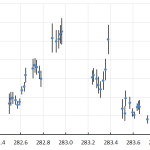A summary of the activity of the CAMS BeNeLux network during the month of April 2019 is presented. 2534 orbits were collected during 29 nights with a maximum of 84 operational cameras at 20 different CAMS stations. Favorable weather circumstances during the Lyrid activity allowed to monitor the April Lyrid activity for a second year in a row.
1 Introduction
Already since 2013 the month of April tends to be more favorable for astronomical observations than previous winter months. 2018 had been very favorable during the Lyrid activity. Could it be possible to have two years in a row with favorable weather circumstances?
2 April 2019 statistics
The weather improved a lot in April compared to March. As many as 8 nights had more than 100 orbits, 3 nights with more than 200 and one night had as many as 367 orbits. Only one single night remained without any orbits. For a second year in a row, the CAMS BeNeLux network enjoyed clear sky during much of the Lyrid activity and 322 orbits could be identified as Lyrids (Johannink, 2019).
Table 1 – April 2019 compared to previous months of April.
| Year | Nights | Orbits | Stations | Max. Cams | Min. Cams | Mean Cams |
| 2012 | 6 | 11 | 4 | 2 | 2.0 | |
| 2013 | 19 | 140 | 9 | 10 | 6.5 | |
| 2014 | 19 | 421 | 12 | 29 | 18.8 | |
| 2015 | 27 | 1212 | 15 | 43 | 33.9 | |
| 2016 | 26 | 971 | 17 | 50 | 15 | 37 |
| 2017 | 28 | 1235 | 20 | 60 | 32 | 48.2 |
| 2018 | 27 | 1929 | 21 | 83 | 59 | 73.3 |
| 2019 | 29 | 2534 | 20 | 84 | 44 | 67.7 |
| Total | 181 | 8453 |
CAMS BeNeLux captured 14667 meteors of which 7894 or 54% proved multiple station which resulted in 2534 orbits. This is the best score ever for the month of April in terms of orbits and clear nights. The maximum of 84 cameras available compares well with April 2018 (83 cameras), but the minimum number of cameras dropped from 59 in 2018 to 44 in April 2019. This was mainly due to a number of technical hardware incidents at CAMS stations with AutoCAMS. On average 67.7 cameras were operational against 73.3 in April 2018.
In total CAMS BeNeLux collected 8453 orbits during 181 April nights accumulated during the past 8 years. The statistics for April 2019 are compared in Table 1 with all previous months of April since the start of the CAMS BeNeLux network.

Figure 1 – Comparing April 2019 to previous months of April in the CAMS BeNeLux history. The blue bars represent the number of orbits, the red bars the maximum number of cameras running in a single night and the yellow bars the average number of cameras running per night.
Figure 1 shows the decline in average operational cameras compared to 2018. This combined with considerable better weather circumstances than in 2018 resulted in a record number of orbits for the month of April.
On April 22 CAMS BeNeLux detected an outburst of 15 Bootids (#923). 7 orbits of this shower were registered during a two-hour period. The United Arab Emirates CAMS network confirmed this event and detected 4 more orbits during the same two-hour interval.
3 Conclusion
April 2019 brought exceptional favorable weather for the CAMS BeNeLux network. Just like in 2018 clear nights during much of the Lyrid activity period resulted in a record number of Lyrid orbits.
Acknowledgment
Many thanks to all participants in the CAMS BeNeLux network for their dedicated efforts. The data on which this report is based has been taken from the CAMS website (http://cams.seti.org/FDL/index-BeNeLux.html). The CAMS BeNeLux team is operated by the following volunteers:
Hans Betlem (Leiden, Netherlands, CAMS 371, 372 and 373), Jean-Marie Biets (Wilderen, Belgium, CAMS 380, 381 and 382), Martin Breukers (Hengelo, Netherlands, CAMS 320, 321, 322, 323, 324, 325, 326 and 327, RMS 328 and 329), Bart Dessoy (Zoersel, Belgium, CAMS 397, 398, 804, 805 and 806), Jean-Paul Dumoulin and Christian Walin (Grapfontaine, Belgium, CAMS 814 and 815), Luc Gobin (Mechelen, Belgium, CAMS 390, 391, 807 and 808), Tioga Gulon (Nancy, France, CAMS 3900), Robert Haas (Alphen aan de Rijn, Netherlands, CAMS 3360, 3361, 3362, 3363, 3364, 3365, 3366 and 3367), Robert Haas (Texel, Netherlands, CAMS 810, 811, 812 and 813), Robert Haas / Edwin van Dijk (Burlage, Germany, CAMS 801, 802, 821 and 822), Klaas Jobse (Oostkapelle, Netherlands, CAMS 3030, 3031, 3032, 3033, 3034, 3037, 3038 and 3039) , Carl Johannink (Gronau, Germany, CAMS 311, 312, 313, 314, 315, 316, 317 and 318), Hervé Lamy (Dourbes, Belgium, CAMS 394 and 395), Hervé Lamy (Humain Belgium,, CAMS 816), Hervé Lamy (Ukkel, Belgium, CAMS 393), Koen Miskotte (Ermelo, Netherlands, CAMS 351, 352, 353 and 354), Tim Polfliet (Gent, Belgium, CAMS 396), Steve Rau (Zillebeke, Belgium, CAMS 3850 and 3852), Paul and Adriana Roggemans (Mechelen, Belgium, CAMS 383, 384, 388, 389, 399 and 809, RMS 003830), Hans Schremmer (Niederkruechten, Germany, CAMS 803) and Erwin van Ballegoij (Heesch, Netherlands,CAMS 347 and 348).
References
Johannink C. (2019). “CAMS BeNeLux results April 2019”. eMetN, 4, 193–184.




